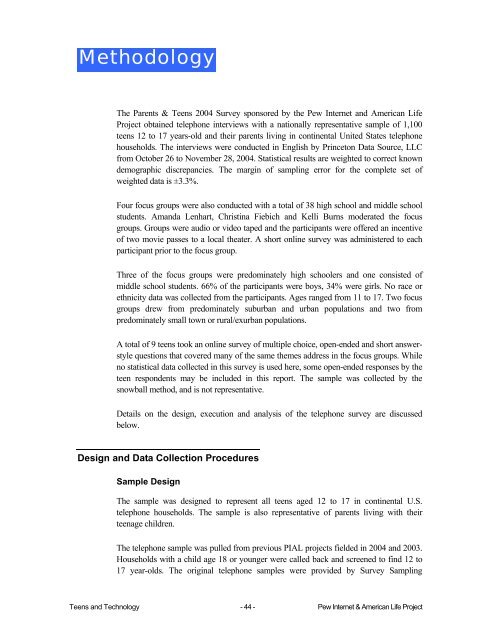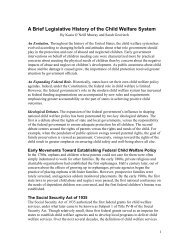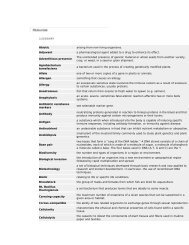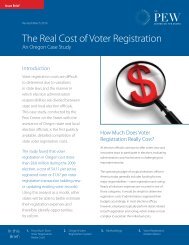Teens and Technology - Pew Internet & American Life Project
Teens and Technology - Pew Internet & American Life Project
Teens and Technology - Pew Internet & American Life Project
Create successful ePaper yourself
Turn your PDF publications into a flip-book with our unique Google optimized e-Paper software.
Methodology<br />
The Parents & <strong>Teens</strong> 2004 Survey sponsored by the <strong>Pew</strong> <strong>Internet</strong> <strong>and</strong> <strong>American</strong> <strong>Life</strong><br />
<strong>Project</strong> obtained telephone interviews with a nationally representative sample of 1,100<br />
teens 12 to 17 years-old <strong>and</strong> their parents living in continental United States telephone<br />
households. The interviews were conducted in English by Princeton Data Source, LLC<br />
from October 26 to November 28, 2004. Statistical results are weighted to correct known<br />
demographic discrepancies. The margin of sampling error for the complete set of<br />
weighted data is ±3.3%.<br />
Four focus groups were also conducted with a total of 38 high school <strong>and</strong> middle school<br />
students. Am<strong>and</strong>a Lenhart, Christina Fiebich <strong>and</strong> Kelli Burns moderated the focus<br />
groups. Groups were audio or video taped <strong>and</strong> the participants were offered an incentive<br />
of two movie passes to a local theater. A short online survey was administered to each<br />
participant prior to the focus group.<br />
Three of the focus groups were predominately high schoolers <strong>and</strong> one consisted of<br />
middle school students. 66% of the participants were boys, 34% were girls. No race or<br />
ethnicity data was collected from the participants. Ages ranged from 11 to 17. Two focus<br />
groups drew from predominately suburban <strong>and</strong> urban populations <strong>and</strong> two from<br />
predominately small town or rural/exurban populations.<br />
A total of 9 teens took an online survey of multiple choice, open-ended <strong>and</strong> short answerstyle<br />
questions that covered many of the same themes address in the focus groups. While<br />
no statistical data collected in this survey is used here, some open-ended responses by the<br />
teen respondents may be included in this report. The sample was collected by the<br />
snowball method, <strong>and</strong> is not representative.<br />
Details on the design, execution <strong>and</strong> analysis of the telephone survey are discussed<br />
below.<br />
Design <strong>and</strong> Data Collection Procedures<br />
Sample Design<br />
The sample was designed to represent all teens aged 12 to 17 in continental U.S.<br />
telephone households. The sample is also representative of parents living with their<br />
teenage children.<br />
The telephone sample was pulled from previous PIAL projects fielded in 2004 <strong>and</strong> 2003.<br />
Households with a child age 18 or younger were called back <strong>and</strong> screened to find 12 to<br />
17 year-olds. The original telephone samples were provided by Survey Sampling<br />
<strong>Teens</strong> <strong>and</strong> <strong>Technology</strong> - 44 - <strong>Pew</strong> <strong>Internet</strong> & <strong>American</strong> <strong>Life</strong> <strong>Project</strong>
















